|
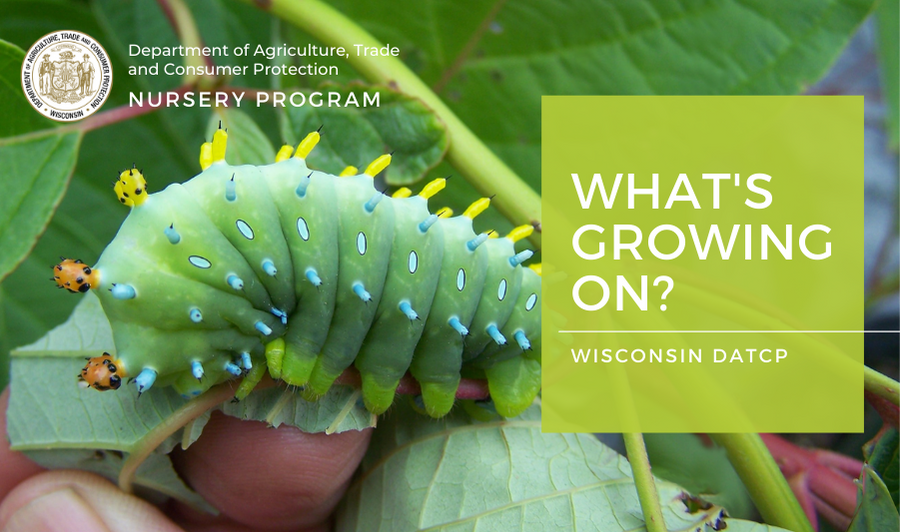 _____________________________________
Dear Wisconsin nurseries, Christmas tree growers, and gardeners:
As we are now well into the growing season, be sure to include scouting for pests and diseases as part of your regular management routine. Below are a few pest and disease updates from the DATCP nursery program.
Please send any feedback, questions, or ideas for future e-news updates to datcpnursery@wisconsin.gov.
Having trouble viewing this email? View it as a Web page.
_____________________________________
|
|
|
Elongate Hemlock Scale female and crawlers | DATCP image
|
|
|
In April 2022, plant protection inspectors detected Elongate Hemlock Scale (EHS) on hemlock nursery stock during routine inspections in southeast Wisconsin. The hemlock trees were shipped to Wisconsin from an out of state supplier. The nursery stock on site at the time of inspection was promptly treated to mitigate this pest. While precautionary measures were taken, there is concern some hemlock trees from this shipment were sold to customers prior to inspection and treatment.
EHS is a non-native, invasive scale insect that feeds on eastern hemlock, fir, and spruce. EHS produces 1-2 generations a year. The insects wrap themselves in a hard, waxy coating, which creates the distinctive “scale” visible on needles. Due to these characteristics, EHS is difficult and expensive to control with pesticides.
EHS poses a risk to Wisconsin’s Christmas trees, native hemlock forests, other coniferous forests, and ornamental evergreens. To date, EHS has not been found in Wisconsin’s forests or Christmas tree fields.
Signs of EHS infestation include: yellowing of needles on the interior of the lower branches; scale coverings on the underside of needles; premature needle drop with eventual branch and limb dieback and death of tree with severe infestations; or the tree may appear flocked.
Landscapers and homeowners should closely inspect newly planted hemlock trees for EHS. Prune out and destroy any suspect infested branches or return the plant material to the nursery.
Suspect EHS infested trees may also be reported to DATCP’s pest hotline at (866) 440-7523 or datcppesthotline@wi.gov.
|
|
_____________________________________ |
|
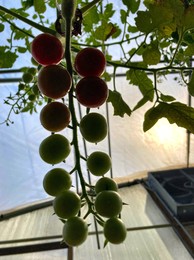
In 2011, the Food Safety Modernization Act (FSMA) was signed into law, representing the first overhaul of U.S. food safety laws in almost 70 years. FSMA includes new regulatory standards for produce destined for fresh market sale, called the Produce Safety Rule (PSR). The PSR establishes minimum standards for the growing, harvesting, packing, and holding of fresh fruits and vegetables that are typically eaten raw.
While the PSR applies to all farms, including nurseries, not all farms are subject to the rule. There are exemptions and exclusions, depending on the amount of produce sales, overall amount of food sales, type of commodities grown, and the buyer. Farms are subject to the rule if they grew and sold “covered produce” (leafy greens, melons, tomatoes, berries, apples, etc.) to people or businesses that eat, prepare, or distribute produce to other markets.
Nurseries typically do not sell “produce” according to the PSR, which is the “edible reproductive body of a seed plant or tree nut” or “edible part of an herbaceous plant." Since the products sold are usually not edible, they are not subject to PSR oversight. An exception that could fall under the rule is if the nursery also grew and sold fresh market produce or otherwise distributing fresh market commodities. However, nurseries would also be eligible for the same farm exemptions and exclusions.
If you would like to learn more about FSMA and the PSR, or if you have questions about your farm’s status, contact Safe Wisconsin Produce at (608) 224-4511 or email safeproduce@wi.gov or visit https://safeproduce.wi.gov.
|
_____________________________________
|
|
|
Boxwood blight is a disease threatening boxwoods in Wisconsin’s nursery industry and landscape. Boxwood blight is caused by the fungus Calonectria pseudonaviculata and impacts boxwood shrubs, leading to leaf loss, branch dieback, and shrub death. Boxwood Blight was first confirmed in Wisconsin in 2018 and is still considered an emerging threat in the state.
Symptoms of Boxwood blight include:
- Brown leaf spots that enlarge and merge with black necrotic edges.
- Defoliation (leaves fall off) of infected leaves.
- Black streaks on stems and branch dieback.
- White fungal fruiting bodies may be visible on symptomatic leaf undersides and stems during humid weather.
|
|
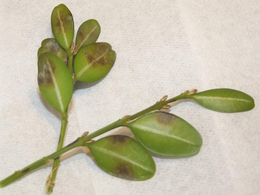 Symptoms of Boxwood blight include brown leaf spots that enlarge and merge. Photo credit: Sandra Jensen, Cornell University, Bugwood.org
|
 Black streaks on stems caused by Calonectria pseudonaviculata. Photo credit: Mary Ann Hansen, Virginia Polytechnic Institute and State University, Bugwood.org
|
|
|
There are several other pathogens that cause similar symptoms to boxwood blight but are not as destructive or impactful to the nursery industry. These include Volutella blight (caused by Coccinonectria pachysandricola, Pseuduonectria buxi and Pseudonectria foliicola) and Macrophoma leaf spot (a weak pathogen caused by Macrophoma candollei).
Symptoms of Volutella blight include:
- Often colonizes tissues damaged by winter injury.
- Infected leaves turn yellow or bronze and are retained.
- Affected branches have loose bark, wood discoloration, and dieback.
- In humid weather, salmon pink fungal fruiting bodies can be visible on impacted leaves and stems.
Symptoms of Macrophoma leaf spot include:
- Leaf spots and straw colored leaves.
- Black, raised fruiting bodies on dead and dying leaves.
|
|
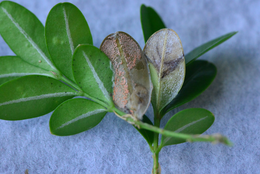 Pink fungal fruiting bodies of volutella blight on the left leaf, and white fungal fruiting bodies on the right leaf of boxwood blight, David L. Clement, University of Maryland, Bugwood.org
|
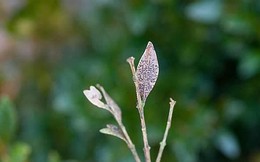 Black, raised fruiting bodies of Macrophoma leaf spot on boxwood. Photo: David L. Clement, University of Maryland
|
|
|
If you suspect your plants may be infected and are a licensed nursery grower or dealer, contact DATCP’s Nursery Program at (608) 224-4572 or datcpnursery@wisconsin.gov. If you are a homeowner, contact the University of Wisconsin-Madison Plant Disease Diagnostic Clinic at https://pddc.wisc.edu/.
_____________________________________
|
|
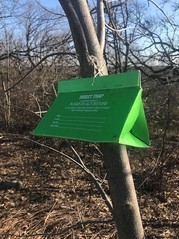
DATCP will be setting more than 10,000 traps for spongy moth, formerly known as gypsy moth, in 2022. The traps will be placed in 47 counties in western and central Wisconsin from mid-May through early July. DATCP requests that property owners allow trappers access to place traps and to not disturb the traps once in place.
Traps are small green boxes tied to tree branches. The trap contains the scent of a female spongy moth that is undetectable to other insects and is used to attract and catch adult male spongy moths. Traps are a monitoring tool used to estimate population size and make management decisions.
Trappers, who wear fluorescent vests and carry identification cards, monitor traps until the male moths stop flying in August, at which time the traps are removed. Each trap is labeled with a phone number that property owners can call if they have questions or decide they want it removed.
For more information on spongy moth trapping:
|
_____________________________________
|
|
|
_____________________________________
|
|
|
|
|